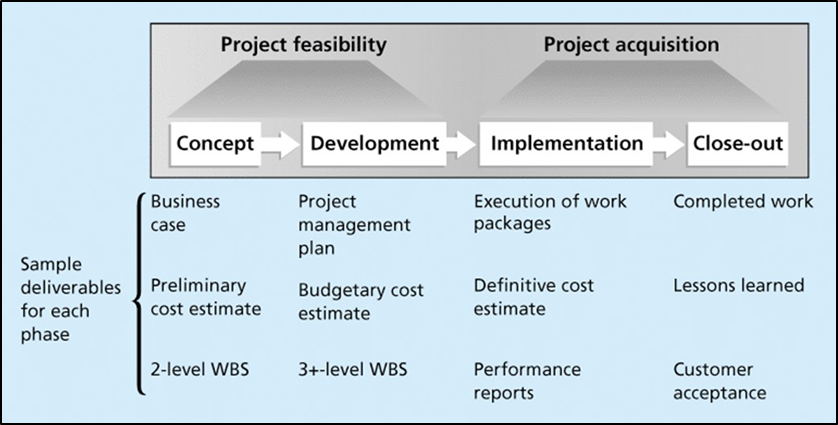Phases of a Project Life Cycle
Organizations do projects, and the analogy of a project having a life cycle is appropriate in many ways. In Lesson 1, we talked about a project as a temporary endeavor. If you've ever been involved in a project you've despised, this is great news, it has to end sometime! Projects are also conceived and go through phases. We will break down projects into four phases:
- Concept
- Development
- Implementation
- Close-out
Schwalbe (2016) illustrates the phases of a project life cycle and associated deliverables in Figure 2-1 below.

Click for a text description of figure 2-1: Phases of the Project Life Cycle
The figure explains the main phases typically involved in the start-up, planning, and execution of all projects. These phases are shown as four boxes with connecting arrows pointing from left to right. Two of the phases, Concept, and Development establish the feasibility of the project and the foundation for execution. Above these two phase boxes is a text label, "Project Feasibility". Below each Phase box is a list of "sample deliverables". Types of deliverables for the Concept Phase include a "business case", "preliminary cost estimate", and an initial plan--typically a 2-level Work Breakdown Structure (WBS). The "Development Phase" includes a "project management plan", "budget estimate", and a more detailed WBS (3-level). To the right of the first two phase boxes are boxes for the Implementation and Close-out phases. Above these two phase boxes is a text label, "Project Acquisition." Deliverables associated with the "Implementation Phase" typically include completion of work and performance reports. The Close-out Phase includes the confirmation of all completed work (consistent with the plan) and a "Lessons-Learned" evaluation--a compilation of good and bad project practices and results that may be used to improve future project management.
The concept and development phases look at the project feasibility. The concept phase involves a rough assessment of the project, why it may be beneficial, and preliminary cost estimates. Projects that require too large an investment in time, or are inappropriate or too expensive for an organization, should be disregarded or culled at this time. In this class, we will move through the concept phase in Lesson 3 and create a summary document called a project charter.
The development phase fleshes out all aspects of the project charter, including what the project will accomplish, who will do the work, how much time it will take, and what it will cost. At the end of the development phase, no actual work has been done on the project, although all the planning is complete. In this class, we will move through the development phase in Lessons 4-10 and create a summary document called a project plan.
The implementation and close-out phases focus on doing and delivering the work for the project. In the implementation phase, the team creates those things outlined in the project plan, called the deliverables. Implementation also involves controlling any changes to the plan, including changes in budget, timing, or deliverables. In the close-out phase, the work is complete and delivered. In this phase, the customer may be queried regarding the acceptability and quality of the project. In this class, we will not have time to work a project through the implementation and close-out phases.
Read Croswell, Chapter 2 for a discussion of project phases in typical GIS development projects.